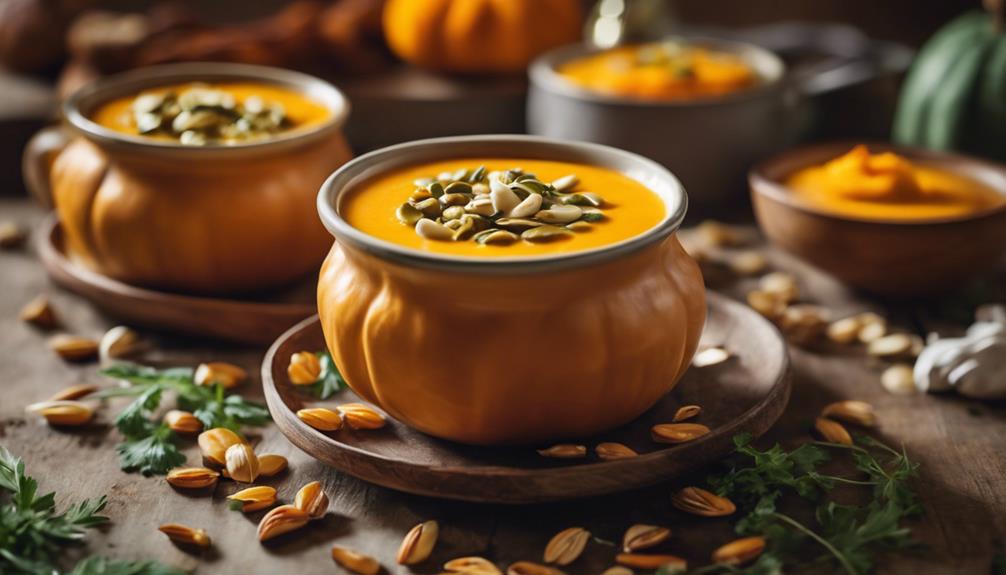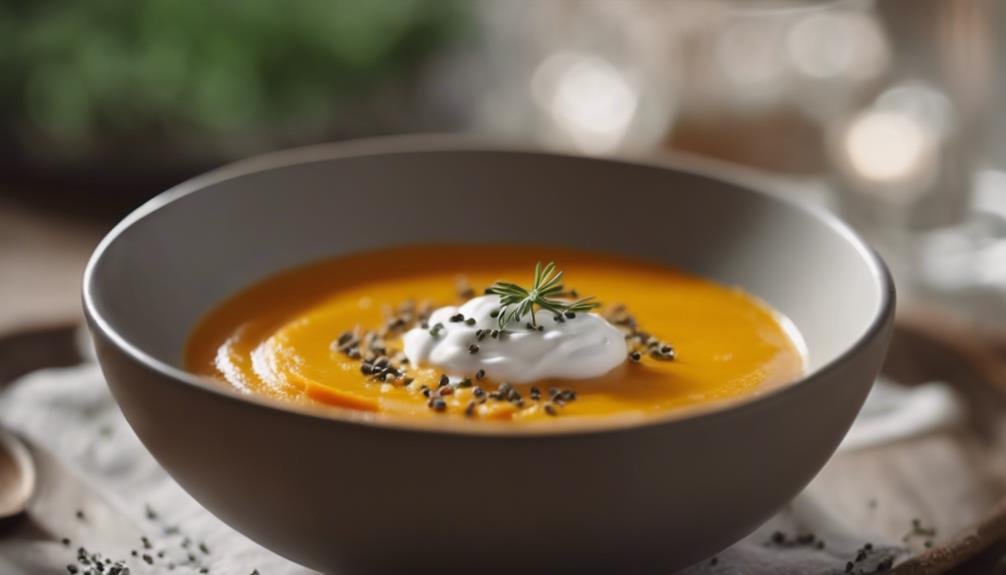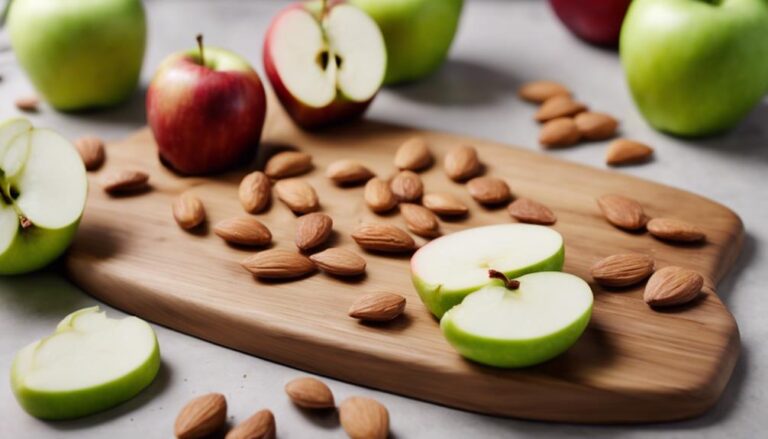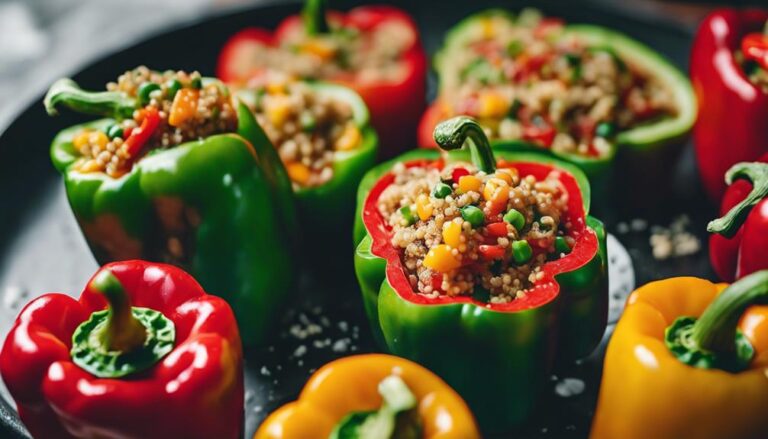Sous Vide Butternut Squash Soup
Experience the exquisite sous vide butternut squash soup by infusing precise cooking with the flavors of autumn. Seal butternut squash with seasonings in a vacuum bag, then gently cook in a water bath until tender. Blend the cooked squash into creamy perfection. Enhance with cinnamon, nutmeg, or cumin for depth. Experiment with garnishes like toasted pumpkin seeds or coconut cream for texture and flair. Whether you prefer velvety smooth or chunky textures, this soup offers versatility for your culinary exploration. Uncover more variations and blending techniques to elevate your at-home dining experience.
What You Will Learn Here
- Sous vide method retains squash flavor and nutrients.
- Precise temperature control ensures vibrant color and taste.
- Slow cooking process enhances soup's depth and richness.
- Sous vide provides consistent texture and doneness.
- Infusing flavors with minimal ingredient loss.
Squash Soup Origins

The origins of squash soup date back to ancient times when early civilizations began crafting soups for sustenance and flavor. Throughout history, squash soup recipes evolved, incorporating various ingredients and cooking techniques to create diverse flavors and textures.
This culinary tradition of squash soup has spread across cultures, each adding its unique twist to this comforting and nutritious dish.
Soup Origins Brief History
Delving into the origins of squash soup, one uncovers a rich culinary history woven into the fabric of diverse cultures. The roots of squash soup can be traced back to ancient civilizations where soups were a staple due to their ability to combine various ingredients into a nourishing and easy-to-digest meal. Culinary traditions around the world have embraced soups for their versatility and comforting nature, with each culture adding its unique twist to these liquid concoctions.
In the case of squash soup, early recipes likely emerged from regions where squash was abundant, such as the Americas. Native American tribes were known to incorporate squash into their diets, often turning them into savory dishes like soups. As explorers and settlers spread across the continents, the concept of squash soup evolved, adapting to local ingredients and tastes. Over time, squash soup became a beloved dish enjoyed during cold seasons, cherished for its warmth and wholesome flavors that continue to delight palates today.
Squash Soup Evolution
Exploring the evolution of squash soup reveals a fascinating journey of culinary adaptation and innovation across diverse cultures. Over time, squash soup has undergone significant evolutionary trends, adapting to the changing palates and preferences of different regions. The flavor profiles of squash soup have evolved from simple and earthy to complex and nuanced, reflecting the diverse ingredients and techniques used in its preparation.
Initially, squash soup was a humble dish, with a straightforward flavor profile highlighting the natural sweetness of the squash. However, as culinary traditions mingled and techniques were shared, the soup began to incorporate a wide array of spices, herbs, and other ingredients, leading to a more layered and rich taste experience. This evolution reflects the dynamic nature of cuisine, where flavors are constantly evolving and adapting to new influences.
Origins Across Cultures
Exploring the diverse origins of squash soup reveals a tapestry of cultural influences and culinary traditions. Squash soup has a rich history that spans across various cultures. In North America, Native Americans were among the first to incorporate squash into their diets, creating hearty soups that sustained them through harsh winters. European settlers later adopted and adapted these recipes, adding their own spices and cooking techniques to create the savory squash soups that are familiar to us today.
In Latin America, squash soup has deep roots in indigenous cuisine, where ingredients like chili peppers and corn are often used to add flavor and texture. These culinary traditions have influenced modern squash soup recipes, infusing them with vibrant and bold flavors.
Across Asia, squash soup can be found in different forms, each reflecting the unique cultural influences of the region. From coconut milk-based soups in Thailand to miso-infused variations in Japan, the diversity of culinary traditions shines through in every bowl of squash soup. The global popularity of this dish highlights its versatility and adaptability across cultures.
Key Soup Components
To create a flavorful and well-balanced butternut squash soup, it's essential to carefully consider the key components that will enhance the overall taste and texture of the dish. When crafting your soup, focus on the following key elements:
- Flavor Profiles: Experiment with a blend of spices like cinnamon, nutmeg, or cumin to enhance the natural sweetness of the butternut squash.
- Ingredient Pairings: Complement the squash with ingredients like apples, carrots, or onions to add depth and complexity to the soup.
- Cooking Techniques: Utilize methods like roasting or sous vide to intensify flavors and achieve a silky smooth texture.
- Temperature Control: Maintain precise temperature control during cooking to make sure that the butternut squash retains its vibrant color and nutrients.
- Seasoning: Don't forget to season your soup with salt and pepper to balance the flavors and bring out the natural sweetness of the butternut squash.
Butternut Squash Bisque Variations

When it comes to Butternut Squash Bisque variations, you have some delicious options to choose from.
Try the velvety Butternut Squash Bisque for a smooth and luxurious texture.
If you prefer a richer taste, go for the creamy Butternut Squash Bisque, or add a kick with the spicy version.
Enjoy experimenting with these different flavors to find your favorite!
Velvety Butternut Squash Bisque
For a creamy twist on traditional butternut squash soup, consider these variations to create a velvety butternut squash bisque. When aiming for a luxurious bisque, you can elevate the dish by incorporating seasonal ingredients and mastering culinary techniques. Here are some ideas to help you achieve a velvety butternut squash bisque:
- Coconut Milk Infusion: Add a splash of creamy coconut milk to your butternut squash bisque for a tropical twist.
- Caramelized Onion Garnish: Top your bisque with a generous heap of caramelized onions for added depth and sweetness.
- Toasted Pumpkin Seeds: Sprinkle toasted pumpkin seeds over your bisque for a crunchy texture contrast.
- Sage Brown Butter Drizzle: Drizzle a savory sage brown butter over your bisque just before serving for a burst of flavor.
- Parmesan Crisp: Serve your velvety bisque with a delicate parmesan crisp on top for an elegant touch.
Experiment with these flavor profiles and presentation techniques to craft a velvety butternut squash bisque that will impress your guests.
Creamy Butternut Squash Bisque
Elevate your butternut squash bisque to a creamy delight with these simple variations.
To enhance the flavors of your creamy butternut squash bisque, consider the following options:
- Flavor pairings: Experiment with adding seasonal ingredients like apples or pears to bring a sweet and tangy contrast to the creamy base.
- Seasonal ingredients: Incorporate warm spices such as cinnamon or nutmeg to complement the natural sweetness of the butternut squash.
- Toppings: Sprinkle roasted pumpkin seeds or crispy bacon on top for added texture and depth of flavor.
- Serving suggestions: Pair your creamy bisque with a crusty baguette or a side salad for a complete and satisfying meal.
- Additional garnishes: Fresh herbs like thyme or sage can add a pop of freshness to the rich bisque, enhancing the overall taste experience.
Spicy Butternut Squash Bisque
To add a fiery kick to your butternut squash bisque, consider infusing it with spicy flavors like cayenne pepper or red chili flakes. This variation, known as spicy squash, sweet bisque, offers a delightful contrast between the natural sweetness of the butternut squash and the heat of the spices.
Here are some ways to enhance your bisque:
- Blend in roasted red peppers for a smoky undertone
- Sprinkle some paprika for a touch of earthy spiciness
- Add a dash of curry powder to bring depth of flavor
- Drizzle with a swirl of sriracha for an extra punch
- Garnish with chopped jalapeños for a fresh and vibrant finish
Soup Texture Enhancements
When considering soup texture enhancements, you'll need to decide between creaminess and chunky styles based on your preference. Experiment with blending techniques to achieve the desired consistency, whether smooth or with a bit of texture.
Don't forget the importance of selecting the right garnishes to complement the overall taste and presentation of your butternut squash soup.
Creaminess Vs. Chunky
For a velvety smooth texture in your butternut squash soup, consider blending the ingredients until creamy. When deciding between a creamy or chunky soup, think about the overall flavor profile you want to achieve. Creamy soups tend to have a luxurious mouthfeel and can enhance the natural sweetness of butternut squash. On the other hand, chunky soups provide a more rustic texture and allow you to enjoy the individual components like cubes of squash or other vegetables.
When aiming for a creamy soup, you can pair butternut squash with ingredients like coconut milk, cream, or even a touch of nutmeg to elevate the flavor profile. These additions not only contribute to the creamy texture but also complement the natural sweetness of the squash. If you prefer a chunkier soup, consider leaving some of the squash in larger pieces or adding in ingredients like toasted nuts or croutons for added texture. Ultimately, the choice between creamy and chunky comes down to personal preference and the desired dining experience.
Blending Techniques
Consider experimenting with different blending techniques to enhance the texture of your butternut squash soup. When aiming for a smooth consistency, immersion blending is a convenient method. With this technique, you can blend the soup directly in the pot, creating a velvety texture by breaking down all the ingredients evenly.
On the other hand, if you prefer a chunky texture, hand blending might be more suitable. This method allows you to control the blending process, leaving chunks of butternut squash for a more rustic feel.
To achieve a perfectly smooth consistency, make sure that you blend the soup in batches if using a traditional blender. This will prevent any potential splattering and help achieve a uniform texture throughout. Conversely, if you opt for a chunkier texture, be mindful of the blending time to avoid over-processing the soup.
Experiment with these blending techniques to find the perfect texture that suits your preferences when preparing your delicious sous vide butternut squash soup.
Garnish Selection
Experiment with various garnishes to elevate the texture and presentation of your sous vide butternut squash soup. Adding flavorful toppings can enhance the taste and visual appeal of your dish. Consider sprinkling toasted pumpkin seeds for a crunchy texture or drizzling a swirl of coconut cream for a creamy finish. These simple additions can take your soup to the next level, providing a delightful contrast to the smoothness of the butternut squash base.
For presentation ideas, try arranging thinly sliced apple or pear on top of the soup for an invigorating and seasonal touch. You can also get creative with seasonal garnishes like pomegranate arils or a sprinkle of cinnamon for a festive flair. These garnishes not only add visual interest but also introduce complementary flavors that will impress your guests.
Experimenting with different seasonal and creative garnishes allows you to tailor the soup to your preferences and showcase your culinary creativity. So, don't be afraid to play around with various toppings to find the perfect combination that enhances your sous vide butternut squash soup.
Final Thoughts

To wrap up, reflect on the delightful flavors and comforting warmth that this Sous Vide Butternut Squash Soup brings to your table. The soup consistency is velvety smooth, thanks to the precision of the sous vide cooking method, ensuring a luxurious texture that coats your palate with every spoonful. The flavor profiles of the butternut squash, subtly sweet and earthy, are enhanced by the gentle infusion of aromatic herbs and spices during the cooking process. Each ingredient harmonizes to create a symphony of taste that's both familiar and exciting.
As you savor each mouthful, you'll appreciate the depth of flavors that develop over time as the ingredients meld together. The richness of the soup is balanced perfectly, neither too heavy nor too light, making it a versatile dish suitable for any occasion. Whether enjoyed as a comforting meal on a chilly evening or as an elegant starter at a dinner party, this Sous Vide Butternut Squash Soup is sure to impress with its exquisite taste and luxurious texture.
Frequently Asked Questions
Can Other Types of Squash Be Used Instead of Butternut Squash?
Yes, other squash varieties can be used as substitutions for butternut squash. Each squash has unique flavor profiles. For example, acorn squash is sweeter, while spaghetti squash has a milder taste. Experiment to find your favorite!
Are There Any Garnish Recommendations to Enhance the Soup?
For a delightful touch, consider adding flavorful toppings like crispy bacon or toasted pumpkin seeds. Seasonal herbs like fresh thyme or rosemary can elevate the presentation. Crunchy toppings such as croutons or fried sage leaves are also excellent choices.
How Can the Soup Be Adapted for a Vegan Diet?
To adapt the soup for a vegan diet, consider using vegetable broth instead of animal-based broths. Flavor substitutions like miso paste or nutritional yeast can enhance taste. Ingredient alternatives like coconut milk offer creaminess. Cater to taste preferences and explore nutritional benefits of plant-based options.
Can the Soup Be Made Ahead of Time and Reheated?
Yes, you can definitely make the soup ahead of time and reheat it. For best results, store it properly in airtight containers in the fridge. When reheating, consider low and slow methods to preserve flavors.
Are There Any Alternative Cooking Methods for This Soup?
For a quick alternative to sous vide, you can roast the butternut squash for a flavorful twist. If you prefer a hands-off approach, try using an Instant Pot or a slow cooker. Stovetop cooking is also an option.
Conclusion
To sum up, sous vide butternut squash soup offers a delicious and versatile option for a comforting meal. With its origins rooted in traditional squash soup recipes, this dish combines key components like butternut squash and various seasonings to create a rich and flavorful bisque.
By experimenting with different variations and textures, you can customize this soup to suit your taste preferences. Whether you prefer a smooth and creamy consistency or a chunkier texture, sous vide butternut squash soup is sure to satisfy your cravings.











